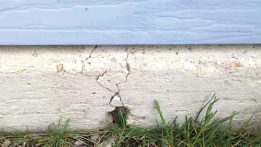 The warm weather is here, and with it usually comes a spiked energy bill. North Florida heat is notoriously brutal on homeowners and their wallets. Ceiling fans have always been a great alternative to A/C units, but many homeowners are often dissatisfied with the performance of their ceiling fans and/or are unaware of their potential value. With the right fan, you can soon lounge around in the comfort of your cooled home without worrying about how hefty your energy bill is going to be at the end of the month.
The warm weather is here, and with it usually comes a spiked energy bill. North Florida heat is notoriously brutal on homeowners and their wallets. Ceiling fans have always been a great alternative to A/C units, but many homeowners are often dissatisfied with the performance of their ceiling fans and/or are unaware of their potential value. With the right fan, you can soon lounge around in the comfort of your cooled home without worrying about how hefty your energy bill is going to be at the end of the month.
Fan Design
 Many homeowners lament the poor air circulation provided by their ceiling fans. Not all fans are created equal, and if you scoff at the idea of using your ceiling fan rather than the A/C unit, you may be in the group of homeowners suffering with inefficient ceiling fans. Below, you will find certain design aspects for ceiling fans that can make all the difference in output. If you find that these elements do not match up with your current fan setup, you may want to look into adjusting your fan or even replacing it altogether.
Many homeowners lament the poor air circulation provided by their ceiling fans. Not all fans are created equal, and if you scoff at the idea of using your ceiling fan rather than the A/C unit, you may be in the group of homeowners suffering with inefficient ceiling fans. Below, you will find certain design aspects for ceiling fans that can make all the difference in output. If you find that these elements do not match up with your current fan setup, you may want to look into adjusting your fan or even replacing it altogether.
- Height: For homeowners that will be installing brand new fans or even those that are looking to make adjustments to their current set up, it is important to take measurements of the different rooms in which the fans will be placed. If your fan hangs too low, you do not get the kind of power and air circulation you would like. If the fan is too high, you may be missing out on the benefits of a fan because you lose significant air circulation near the floor. Most rooms are a standard height of 8ft from floor to ceiling, but if your ceiling hangs a little lower, just be sure to try to get the fan as close to 7ft as possible so that there is enough space for air circulation. If your space is higher than 8ft, you want your fan to hang about 8 or 9ft above the ground.
- Pitch: Blade pitch refers to the degree at which the blades on your fan are angled downward. Blades with a relatively small pitch work better than those that are angled more steeply downward. If your blades have a steep angle, your fan’s motor has to work harder to reach the same level of input as a fan with slightly angled blades.
- Blade Type and Size: Contrary to popular belief, bigger blades do not equal more power. Blades should not be too long or broad because this requires the motor to work much harder to move the heavy blades. Blades that are too small and narrow, however, are not the best option either because they cannot move much air around the room. For a standard room (400 sq ft), you typically want blades with a 50-52” blade span. If your room is smaller, you want to look for smaller blades, and the opposite is true if the room is larger than the standard size.
- Blade Count: More than three blades can result in a quieter fan. Nonetheless, be aware that the more blades you have, the more drag is present, so the blades will be moving more slowly and, consequentially, less productively.
- Speed: Revolutions per minute (RPM) is what you want to pay attention to when dealing with your fan speed. As one could imagine, the faster the blades move, the more airflow you can achieve in your space. Ideally, you would want a fan that has a range of speed settings so that you can control just how much airflow you get and adjust it as needed to feel comfortable.
- Motor: Probably the most important feature of your fan is the motor. It stands to reason that the highest powered motors provide the best air circulation for your space. These motors tend to be quite expensive, so it is important to do research and weigh your options. It is also important to keep in mind energy efficiency and other perks, such as quietness and life span. Be sure to take into account the size of the room where the fan is located and how much power needs to be generated.
Energy Savings
Ceiling fans are a popular choice during the warmer months because they are known to be a cheaper alternative to cranking your A/C down 10 degrees. For the skeptics, understand that fans do not lower the temperature in your home, but they create a wind chill effect that allows you to feel comfortable even when you bump your A/C up a few degrees. What this means is that you can run your A/C at a temperature higher than you normally would, saving you some money on your energy bill. For a comparison, central A/C units can run you about $0.36/hour while a ceiling fan only costs about $0.01/hr. If you run your fan during the summer months, you will be able to reduce the energy usage of your A/C unit and save some money!
Added Perks
If saving money wasn’t enough of an incentive, you may also want to know that ceiling fans can help keep pesky mosquitoes at bay. Intuitively, one would think that an air current in a room would make it harder for mosquitoes and other insects to fly around and be bothersome. While this is true, it is not the only reason why ceiling fans can help you combat those pesky intruders. Ceiling fans also disperse the carbon dioxide that humans exhale. This carbon dioxide is what predominantly attracts mosquitoes in the first place. Without these concentrated amounts of CO2, mosquitoes will be less likely to hang around while you lounge. Furthermore, ceiling fans evaporate sweat which is another attractant for mosquitoes. While you are feeling refreshed and relaxed, know that your ceiling fan is helping in more ways than just one.
Don’t worry about choosing between a cool house and a padded wallet this season; make use of your ceiling fan, and enjoy both! Be sure to inspect your ceiling fans and determine if they need an upgrade. As you search for a new fan, remember to consider a professional’s opinion. While buying a generic “one size fits all” fan from a big-box store may save you a little bit of money at the time of purchase, you may be missing out on a greater investment by not consulting a professional supplier. Seeking advice from someone who specializes in fans can help you make the right choice and get the most out of your fan. To all the Floridians dreading the heat, don’t forget that the ceiling fan can be your best friend! ![]()
Katerin Rodriguez
Home & Yard Magazine




